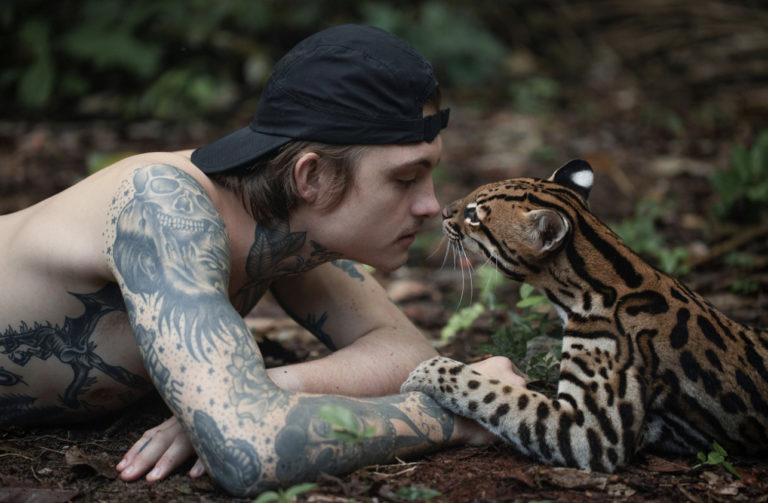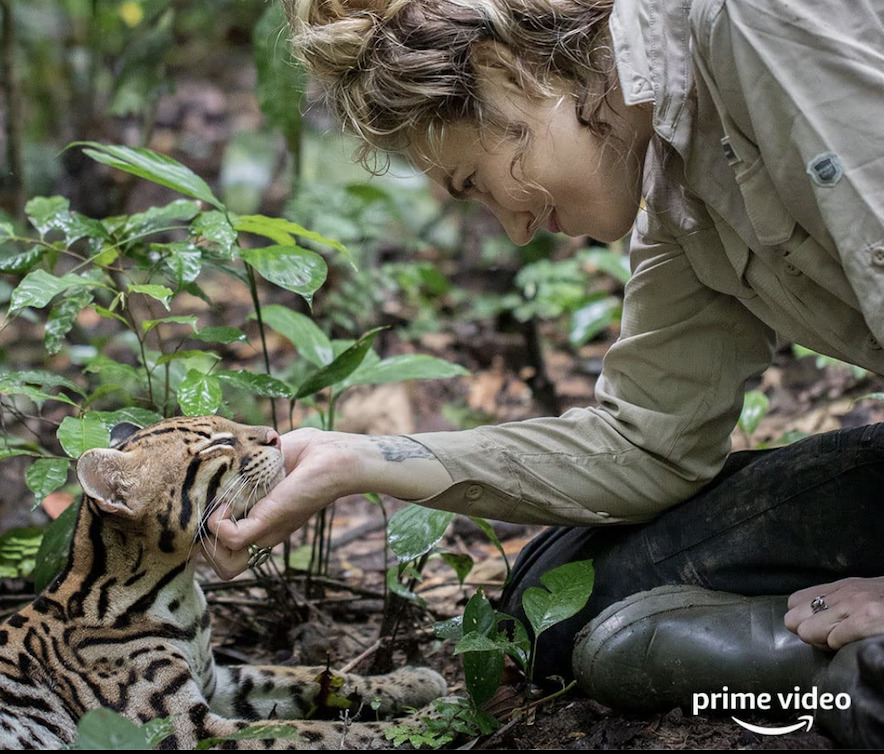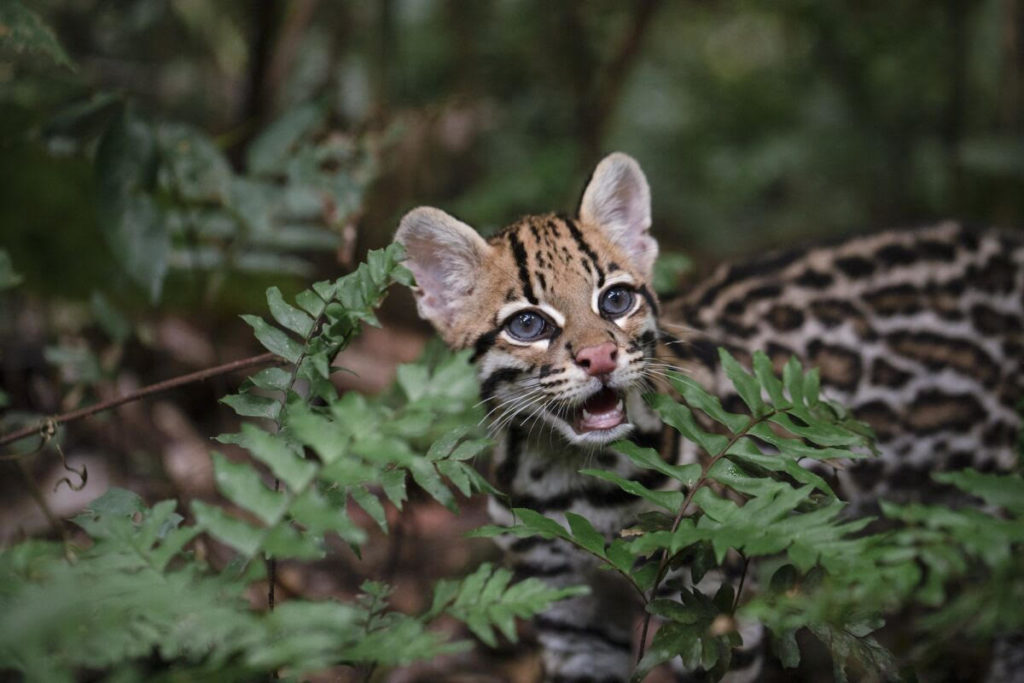
Synopsis : Wildcat follows the emotional and inspiring story of a young veteran (Harry Turner) on his journey into the Amazon. Once there, he meets a young woman (Samantha Zwicker) running a wildlife rescue and rehabilitation center, and his life finds new meaning as he is entrusted with the life of an orphaned baby ocelot. What was meant to be an attempt to escape from life turns out to be an unexpected journey of love, discovery, and healing.

Exclusive Interview with Smantha Zwicker, a tropical biologist and wildlife rehabilitation specialist and the founder and co-director of Hoja Nueva.
Q: “How did you get involved with working with wildlife in Peru?”
SZ: Growing up, I was always really interested in studying in one of the most biodiverse places on the planet. I grew up in nature. I grew up with wildlife, and I started rescuing animals from a pretty young age. I transferred into going into study wildcat populations in the lower Peruvian Amazon. I did it because it was this biodiverse place, also because not a lot had been done in terms of research and conservation. So it’s always exciting to kindof pioneer something new.
Q: You established the organization Hoja Nueva, which helps wounded animals get back into the wild. How did you establish this organization, and how do they function?
SZ: A lot of our rescue and rehabilitation work has happened post-“Wildcat” — post this film. In 2020 my co-director Dylan Singer and I made it our main mission to create and build the first-ever carnivore specialized rehabilitation and re-wilding center, and we built it up to an extent where now we’ve got about 67 animals in our care. We work really closely with local and federal governments to rescue animals from all types of situations: ones that are taken from the wild and put into zoos, or ones that are in the pet trade while they’re being sold in markets. We et them from all different types of situations.
It’s a very rewarding job, but it’s very difficult. I think it’s because there’s not a lot of organizations or people that have specialized in re-wilding, specifically, in the neo-tropics, and specifically with carnivores. It’s a little bit longer-term, more difficult. We’ve got animals with us for sometimes three years before they’re set free. So yeah, it’s very rewarding, but it’s a very hard process at times. It’s definitely a learning experience.
Q: It can’t be easy learning about so many different aspects at the same time. Can you talk about the process of research in re-wilding?
SZ: Yeah. You see in this film the origin story of the first try, essentially, of what we built now. Back then it was just trial and error, and learning as we went, for the most part. For Keanu’s rehabilitation there were many things that went right, but there were a lot of things that went wrong. Oftentimes, it’s the mistakes in those types of situations and the trial and error that you learn from and can grow from and make changes. So we now do re-wilding in a completely different way with very minimal human contacts and very dependent on integrating these animals in their natural environment as much as possible and becoming independent at an earlier age.
Q: Harry Turner fought in the war in Afghanistan and was medically discharged for his depression, and had some traumatic experience in the past. Could you talk about when you first met him?
SZ: I had just started Hoja Nueva and was working a little bit in re-wilding, but mostly in community development efforts, and he was working for a different organization. We just joined efforts a little bit. He had mentioned that he had been in Afghanistan for a couple of months, and about some of his struggles. He was one of those individuals that showed everything at first, so I learned a lot about him even in the first 24 hours of knowing him.
We both come from these backgrounds where there’s trauma that we’ve held on to and learned from. I think a lot of times, working in conservation in general, but working in the jungle in conservation, the majority of the people that I meet have had specific types of trauma in the past which led them to the rainforest and which led them to pursue work that is preserving something — preserving animals, preserving wild places. And we were both there for that purpose in different ways.
Q: There’s so much danger in wildlife: hunters, mining, logging, and wildlife trafficking. What is your strategy to protect the animals and execute the re-wilding plan?
SZ: That’s a great question. It’s very multi-faceted, so it starts with applied conservation, it starts with preserving these landscapes. After Khan [the first ocelot], it was very important for me to pursue acquiring our own proprietary lands as part of a larger corridor. So we, in partnership with other organizations, protect around 30,000 hectares, and we own around three, so about 7,000 acres. We will re-wild our animals on our lands and there we can make sure that it’s safe. We patrol our borders regularly so we know that the place we’re re-inserting these animals is safe.
But it all comes together. It’s all about protecting all of the landscape and addressing the root causes, which is often difficult. I love and I’m very fulfilled by putting animals back into the wild, but a lot of times you really want to take a step back and focus on, why do we have these animals in the first place? Why is the trade increasing? Why are people wanting more wild animals as pets? And start to really refocus our efforts on those root causes so we can create greater change.
Q: In the film, you say “The jungle here change people.” How has your perspective of your life changed after living in the jungle?
SZ: I think it depends on the individual and what each person needs, and when they arrive and what they need to process or go through. The rainforest can be a very healing place. It has a lot to do with being in one of the few remaining intact habitats that’s left in the world, and experience a life that’s outside of society, outside of societal pressures and norms, and outside of self-service, and everything like that.
It’s very empowering. You realize who you are, and for me it was realizing that this place was my home and that’s why I’ve been living there for over nine years now. I think it changes people on an inner level and oftentimes they stay. But sometimes it’s just a stepping stone and it depends on the person
Q: Your team initially shot a lot of the footage by yourself before the filmmakers became involved. At what point did they get involved?
SZ: The filmmakers arrived after the whole process with Khan. I had made it my mission from the beginning because it was going to be the first-ever ocelot reintroduction that had been documented. I really wanted to focus on getting the Sony and shooting everything possible to share the information and share the process — like what we did wrong, what we did right. And then the ending to his life and his story wasn’t the one we had hoped for, but [now] we had this archival footage. When we met Trevor [Frost] and Melissa [Lesh] [the film’s directors], they were extremely interested in the fact that we had this archive of Khan and how everything started, and became a big part of the film.

Q: You said you can tell that some animals never had a “mama”. How can you tell that?
SZ: It comes from experience, and after working with over a hundred animals at this point, you can tell their traumas and what they’ve been through before they got to you. Sometimes when they arrive and they’re pretty young, maybe a few months old, you can tell with how they situate around a human. They want contact because they need that comfort — they need a reason to live. So too, if they’ve gone through that type of trauma or if they’ve been taken from their home and their mother. And you can always tell, because there’s wildness in them but there’s also this like, hope of connection, and wanting to connect with you. That’s why we have a closer relationship with the baby animals until they’re around three or four months old, because it’s very necessary for their development. You can tell when they were taken really soon, and it’s in the way they look at you.
Q: When you release an animal, sometimes it must be very sad. Can you talk about the emotional experience of that process?
SZ: Yeah, it’s extremely difficult because it’s very bittersweet. I think the main two things are to always be focused on the end goal, which is that these animals innately want to be wild and they deserve to be wild, and you have to hold on to that. Because even at times when these animals want to have a greater connection, but it’s past the stage where they should and they should really start to be independent, you have to make the decision to start cutting them off. It’s hurtful; as a compassionate person you feel that pain when you’re walking away and they’re crying for you. It’s very emotional.
By the time that they’re at a stage where they are going off, it’s always more exciting than anything because at that point when we’re releasing them it means that they don’t want the connection with us. It means that they don’t have that desire anymore, and the only desire that they have is to be independent. So by the time they’ve reached that point, we’ve established that they’re ready. When you let them go, it’s very fulfilling because they don’t want to come back. They’re happy to be out there.
We track some of our released animals, but a lot of times we can’t track them completely with cameras or collars or whatever. So we hope for the absolute best and know that we did the best that we could. And we have to hold on to that, especially to help all the future cases that we get.
Q: How did Harry and you balance out raising an ocelot, Keanu? You needed to release him in the wild, but he got bitten by a Brazilian wandering spider.
SZ: There’s a lot of risk involved in rehabilitating wild animals. We have risk even with the animals that grow and develop inside an enclosure. There’s still a risk of different elements and different things that could enter their enclosure. There’s always risk. But it is the most risky, challenging environment on the planet, and it’s what they’re going to face when they’re wild. So it’s really important to expose them to that from a younger age.
In the case of the Brazilian wandering spider that you mentioned, that was the first case where I’d ever seen an animal, including a human, react to a Brazilian spider bite in this part of the jungle. I’ve heard about them from other places, mostly in Brazil. But every person that I had ever seen get bit never had a reaction, so it was really a good learning experience to know that those two bites really affected him and how he processed that venom. He was paralyzed for a bit but he overcame it quickly. It was a good learning experience — all of the challenges are.
Q: What other challenge did you face that you had the most difficulty with?
SZ: I mentioned some of the challenges in our work. For me, the biggest challenge is getting people to participate and care in these issues, and be responsible consumers and tourists — all things that affect wildlife trade and trafficking.
Q: What do you want the audience to take away from this film?
With this film, it’s exciting to be able to have a little bit bigger platform to speak about those issues and to bring people in to how they can help on a daily basis. One of those things is supporting our organization. We now get calls about baby to adult wildcats almost every week. We have over 20 in our care currently, and it’s a really long, arduous process and often an expensive process, so we always like to encourage people. If they care about Khan and Keanu, and all the future cats, to research them and to donate.
Q: Thank you very much.
Check out more of Nobuhiro’s articles.
Here’s the trailer of the film.

